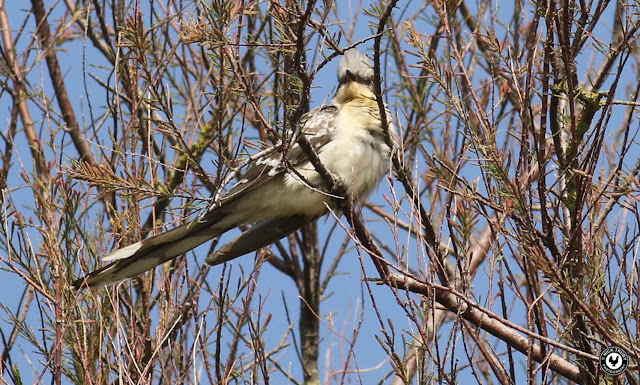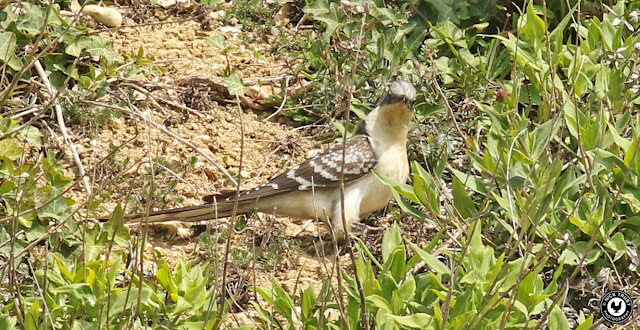I just had to! There couldn't be any further delay. We'd spent Saturday birding around the Portland and Weymouth area and a few times during the day I'd mooted the idea of driving to one of the ferry ports in Hampshire and boarding a ferry in order to twitch a Great Spotted Cuckoo that was being seen at Ventnor on the Isle of Wight. Every time I had convinced myself that it would take too long to get there in the weekend traffic but I still had that nag in my head that I should really have done it anyway. I didn't really enjoy my walk around Farmoor in cold and blustery conditions the next day (which wouldn't have been ideal for twitching) since I was still regretting not going to the IOW the day before. So, sometime on Sunday afternoon, Mrs Caley and I decided that, with the weather set fine for Monday but deteriorating on Tuesday, we had to go. I postponed my work for the day and we headed off south along the A34 early to avoid the worst of the traffic to Portsmouth to board a ferry.
It wouldn't be our first Great Spotted Cuckoo, we saw the one on Portland in May 2016 but that was a first summer juvenile whereas the IOW bird was an adult which are rarely seen outside of their breeding grounds. Great Spotted Cuckoo's are birds of the Mediterranean region, summering chiefly in Iberia, so the bird we were on our way to see would be what is known as an "overshoot" migrant, ie one that has flown too far north probably carried on by the southerly winds that the UK has experienced recently.
 |
| 1st summer Great Spotted Cuckoo, Portland, Dorset, 14/05/2016 |
That old anxiety resurfaced again and the disbelieving devil in me reared its ugly head up once more and I found myself wondering that maybe the earlier sighting was a misidentification. Not sure how anyone could misidentify a Great Spotted Cuckoo though so it had to be still here. We decided to walk eastwards along the promenade to the Cuckoos favoured feeding area but there was no sign. We'd been on site for 45 minutes now and I was getting more than a little bit twitchy! All this way for nothing. Except that we knew the bird was present, one of the birders we had spoken to had seen it, so it should be just a matter of time before it showed again. The promenade, a concrete barrier to the sea, ran underneath a low cliff, the Undercliff, for a quarter of a mile to the east. It was exposed to the breeze and the waves which were lapping up right to the edge of the road. Despite the blue skies and bright sunshine it was quite chilly and I wondered if the Cuckoo had found somewhere more sheltered to feed (I always forget that birds are not as feeble as us humans and don't need comfort). I studied the low bushes right at the top of the cliff since I anticipated that the bird would probably turn up in one of those once it had decided to resume feeding again, since many birds tend to use prominent perches as a lookout to ensure the coast is clear before dropping down to the ground. At 11:15 I noticed a fellow birder waving her arms vigorously and pointing up the cliff about 100 yards back towards the car park, signalling that the Cuckoo was back! A quick look through the binoculars revealed the Cuckoo sat in one of the clifftop bushes! So feeling rather pleased with myself after my earlier evaluation but a tad sad that I hadn't found the bird myself, we set off towards the bird to join the lady who had spotted it. And what a fine looking bird the adult Great Spotted Cuckoo is!
 |
| Great Spotted Cuckoo, Ventnor, IOW, 01/04/2019 |
There was just the "finder" and us looking at the Cuckoo, almost all of the other birders had walked off out of view although a chap we'd been speaking to had realised that the bird had reappeared too since he noticed us hotfooting it and came quickly to join us. The Cuckoo was doing exactly as I thought it would, perching in the bush and surveying the cliff below it. It remained there for a full five minutes before being spooked by a Jackdaw that landed above it and it flew strongly out towards the area that we'd just left. Fortunately I was ready with the camera and managed some decent flight shots as it departed.
The Cuckoo had landed on the cliff face close to the top and now hopped around on the ground in search of food. This particular chalk cliff covered as it is with small plants and shrubs is a breeding area for a very rare species of butterfly, the Glanville Fritillary, which in Britain is only found here on the south coast of the IOW. Thus the local naturalists were experiencing a desperate dilemma since the Great Spotted Cuckoo eats caterpillars and this particular bird had been munching its way through the future Glanville Fritillary population! Initially the bird had favoured Brown-tailed Moth caterpillars, as had the Portland bird in 2016, which it found in the bramble bushes at the base of the cliff, but after that food source had been depleted it had moved on to the rarer treats. I would hate to be the conservationists having to watch their best efforts end up in the belly of a non-native bird. I've never seen a Glanville Fritillary butterfly, unless you can count one of the caterpillars that the Cuckoo was enjoying, and made a note to visit the IOW one summer to see one, but I have a feeling that they may be thin on the ground this summer.
The Great Spotted Cuckoo is about the same size as the more familiar Common Cuckoo which we long to hear every spring (still a few weeks away) but has a proportionately longer tail. The tail makes it seem rather top heavy and as it hopped around on the scrubby ground it frequently seemed to lose balance and end up in some precarious positions whereupon the tail would come into use a stabiliser! The grey and beige colouration of the Cuckoo also afforded it surprising camouflage on the chalky ground and it could be difficult to see at times.
The Cuckoo systematically worked through the plants in search of the caterpillars. We saw it secure at least half a dozen of the insects but it will have found many more. Not easy to see on my photos but I'm assured that they are caterpillars of the rare Glanville Fritillary.
I was rather taken by the Cuckoos feathered legs, presumably an adaptation to feeding in spiny and spiky plants that grow in its natural home. They resembled a pair of three-quarter trousers!
The number of watchers had swelled to around ten or so now that the other birders had caught up. A few locals were interested to know what the attraction was too. Most were content to view from the promenade but there was one chap, isn't there always, who just had to get closer. He was warned from climbing over the barrier which had been erected to stop infringement on the fragile habitat of Glanville Fritillary's and departed in somewhat of a huff. A few minutes later we saw him trying to view the bird from the clifftop! He was only twenty yards or so from the Cuckoo but clearly couldn't see it since he kept trying other vantage points. When he finally locked on to the bird instead of staying put he just had to get closer still and we actually saw him forcing his way through one of the clifftop bushes. As soon as the Cuckoo saw him then it was off, flying back to its refuge in the trees by the carpark. Some recently arrived birders were far from happy, neither was I, with the numpty at the top of the cliff and I hoped for his sake that he stayed up there!
 |
| Maybe they'll have to add "Cuckoo's" to this sign! |
Close to the carpark I decided to look at the brambles at the foot of the cliff and there mostly obscured behind the emerging leaves was the Great Spotted Cuckoo! It remained there mostly unmoving but once or twice made half-hearted efforts at finding food in the branches. It was surprisingly difficult to see within the bush. When the Cuckoo dropped down into a hidden position we decided for the second time to leave.
Our intention to do a bit of birding back on the mainland went by the by because we were both a bit tired. This had been our fifth trip out in the last nine days! I need to get back to work for a rest. We did have time to add Grey Plover and Knot to our year list that now stands at 175. A very satisfying total for just three months and most of the spring and summer migrants still to be recorded plus another visit to Scotland coming up!
































No comments:
Post a Comment